Podcast 186: Reducing Radon, Roof-Shingle Warranties, and What are T-Studs?
This week's installment of the FHB Podcast offers suggestions for dealing with biting insects plus discusses the validity of shingle warranties, the merits of thermally broken studs, and the right way to treat a crawlspace attached to a heated basement.
Follow the Fine Homebuilding Podcast on your favorite app. Subscribe now and don’t miss an episode:
 |
 |
Listener feedback discusses adding Kiley to the regular lineup, another line of defense against biting insects, and more on the environmental impact of work trucks. Then Matt, Kiley, and Patrick take listener questions on lowering radon levels in a basement that already has a radon system, the validity of roof shingle warranties, the pros and cons of thermally-broken T-studs, and how to treat a crawlspace that shares a floor system with a conditioned basement.
Reader Feedback
Adam writes, I’m a podcast junkie and FHB is by far my favorite. I never miss an episode. Only one complaint, what the hell took you guys so long to get Kiley in there? She’s great. And as a father of a little girl it’s so refreshing to hear a woman’s perspective in what is often a male dominated field. #moreKiley
 Nicolas writes, Hey FHB crew, just heard episode 182 I believe where you all talked about mosquitoes woes and the effectiveness of deet. While a high level of deet is still effective to repel insects, there is a better alternative called Permethrin which will kill on contact. It can be applied as a spray or a liquid treatment for laundry.
Nicolas writes, Hey FHB crew, just heard episode 182 I believe where you all talked about mosquitoes woes and the effectiveness of deet. While a high level of deet is still effective to repel insects, there is a better alternative called Permethrin which will kill on contact. It can be applied as a spray or a liquid treatment for laundry.
Samuel from Hood River Oregon writes, I have been doing custom residential construction for 2 years now and love the work. This work required a larger vehicle than my 40mpg 4-door 4-cylinder hatch-back so I started searching for a work rig. I ended up buying one of the worst offenders of the environment for the best price. It is a 1989 F-250 with a 7.3L IDI diesel. I chose this truck because it has an engine with a 400,000mi service life and despite being 30 years old, only had 130,000 miles. It has a bulletproof zf-5 manual transmission, 8ft bed, 4-wheel drive and only set me back 3,500 bucks. Also, being a boat captain for 3 years and maintaining its big diesel meant I could wrench on it myself and save cost there. I don’t’ drive it much, only for hauling tools and lumber but I still wake up in cold sweats thinking about the particulate matter I’m landing on the polar ice caps. I loved the discussion you guys had on work rigs because it’s something I and my coworkers think about all the time. Much like a house, there is no perfect set up for everything and everyone. I did want to share with you guys my dream rig. It is an electric fleet truck that does it all. 80 miles on pure electric, then another 350mi with a combustion generator, 5,000lb towing capacity, all-wheel drive, and you can run power tools right off the truck batteries… doesn’t get better than that. Workhorse W-15 Electric Pickup Truck
 |
 |
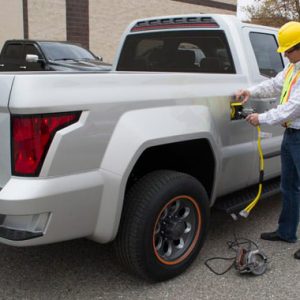 |
Ted from Saline, Michigan writes, I liked the the Episode 183 discussions, very interesting. Re: contractors who are over-trucked, you might appreciate this article: What Does Your Work Truck Say About You? I am not in the trades, but it seems to make a lot of sense to me. My neighbor is a contractor and he’s dong pretty well with a minivan and a trailer instead of a huge truck…. Enjoy, keep up the good work!
Editor Projects
Kiley: Making sawhorses at Hammerstone School in Upstate New York.
Matt: Garden shed staining with a sprayer.
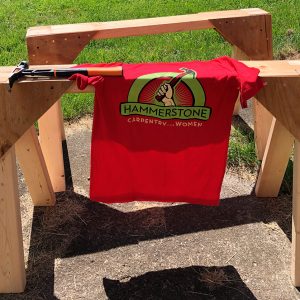 |
 |
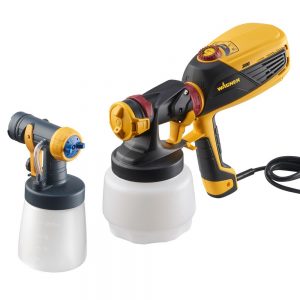 |
Patrick: Flooring restoration project.
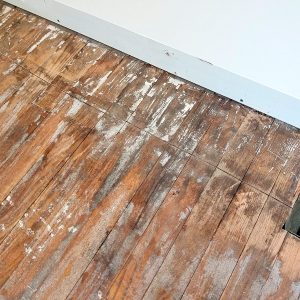 |
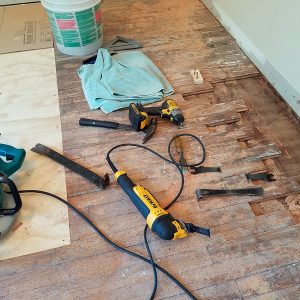 |
 |
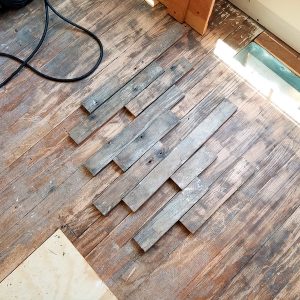 |
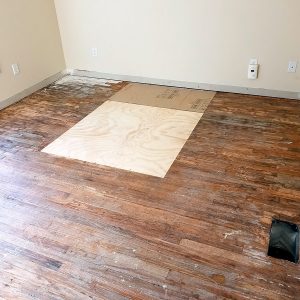 |
Question 1: How do I lower radon levels in a basement that already has a radon system?
Bruce from Hendersonville, NC writes: FHB Podcast guys and Kiley, Thanks to you for your podcast, I find I am more able to listen to the shows than get a chance to sit with my magazine and read an article. The topics are always informative and your presentation entertaining.
I am working on a basement finishing project for a thoughtful client who is working to cut radon levels in his basement down from 2-4 ppm. The under-slab radon remission equipment he was using had him sitting in the mid teens for radon ppm. A local radon expert modified one of these vents to draw air directly from the basement air and this cut the levels to their present ppm of 3 or so. The culprit we believe now to be the concrete walls. Perhaps the radon gas is coming through or from these?
To address this we were talking about framing in front of the exterior concrete walls with 1-5/8″ metal studs (holding these about 1/2″ inside the face of the wall) and applying about 2″ of closed cell foam insulation to achieve an R value of 14, vapor barrier and air barrier. Metal studs would not sponge up any moisture, so it ever water intrusion were a problem interior finishes would be all that would be affected.
On a recent episode I heard one of you mention that you had found the insulation and it was called InSoFast. This caught my ear. Can you speak to how InSoFast’s class 3 rating for vapor barrier would compare to the air and vapor barrier qualities my foam guy boasts about. Could this vapor barrier slow or stop the radon gas intrusion to any significant amount?
BTW we are considering an ERV to replace the radon vent that is currently drawing air from the space.
Thanks in advance for your thoughts,
Related links:
Question 2: What happens if my 20-year shingles only last 10 years?
Dave from Plainfield, VT writes: Hi there FHB podcast crew! I love the podcast. Thank you for keeping it going!
I was listening to you all talk, with a certain briney wit, about how anyone trying to claim a warranty on an asphalt shingle should, basically, collect four leaf clovers and wish upon a shooting star, cuz it ain’t gonna happen. My neighbor is in the throes of a fight with BP over her 25 year shingles blowing off her house in a breeze after a 15 year service life. I found myself saying, “Yeah, good luck with that.” She rolled her eyes, saying, “I know, but someone has to try to hold these b*stards accountable eventually, right?”
So, my question is: What the heck?
How do the shingle companies get away with this? And why do we let them? It’s like some evil joke we all know about and the best we can do is be cynical about it (which, I guess, on some level, is just the simple truth). When I have a client asking about shingle warranties, I say something to the effect of, “well, a 20 year shingle lasts 10 years. A 30 year shingle might last 15. A ‘lifetime’ shingle, well… I guess it’ll last half a lifetime?!? But no one can access the warranty anyway, so just keep an eye on your roof.”
A shingle has a tough job to do, let’s face it. So why the dishonesty? Or why the run-around on fulfilling warranty claims?
I’d love to hear your thoughts on this! Thanks again and #keepcraftalive
Related Links:
- When Is It Time to Reroof?
- Will Your Next Asphalt Roof Last a Lifetime?
- 10 Roof Goofs and How to Fix Them
Question 3: What are the pros and cons of thermally-broken T-studs?
Steve writes, Hi Gang, Hoping you can find some time on a future podcast to discuss T-studs and how they’d affect one’s approach to building efficiency? Thanks!
Related links:
- Insulated Studs? This is a BIG Innovation in Framing!
- Tstud.com
- Tstud Informational Video
- Technical Evaluation of Tstuds
- Breaking the Thermal Bridge
Question 4: How to treat a crawlspace that shares a floor system with a conditioned basement?
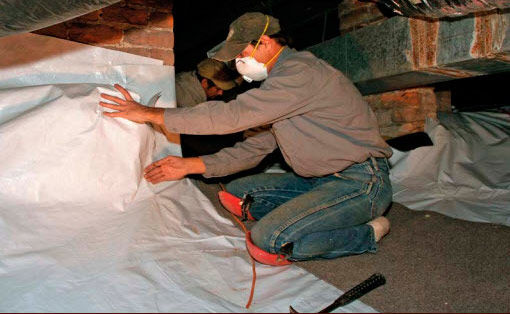
I assumed we need to install an air barrier, something like the drywall we removed from the ceiling of the crawl space. But we need some material that won’t absorb moisture. We had planned to buy 10 mil vapor barrier and install it over the floor and walls of the crawl space. We were then going to add foam board and foam to the rim joists, and install fiberglass insulation on the crawlspace ceiling. But we did not realize that the whole joist bay for the main floor is open to the crawlspace, so now there’s no air barrier (after we removed the drywall ceiling). We’re not sure how/if to seal it off.
Related links:
And lastly:
An unfortunate event – a painter on a jobsite in NY came out to find his car engulfed in flames.
Learn more and register for the Fine Homebuilding Summit.
#KeepCraftAlive
KeepCraftAlive hats help celebrate the value of true craftsmanship–plus 50% of all proceeds from every hat sold go to the #KeepCraftAlive Scholarship Fund, supported by Fine Homebuilding and SkillsUSA.
Buy a #KeepCraftAlive hat or t-shirt
We hope you will take advantage of a great offer for our podcast listeners: A special 20% off the discounted rate to subscribe to the Fine Homebuilding print magazine. That link goes to finehomebuilding.com/podoffer.
The show is driven by our listeners, so please subscribe and rate us on iTunes or Google Play, and if you have any questions you would like us to dig into for a future show, shoot an email our way: [email protected]. Also, be sure to follow Justin Fink and Fine Homebuilding on Instagram, and “like” the magazine on Facebook. Note that you can watch the show above, or on YouTube at the Fine Homebuilding YouTube Channel.
The Fine Homebuilding Podcast embodies Fine Homebuilding magazine’s commitment to the preservation of craftsmanship and the advancement of home performance in residential construction. The show is an informal but vigorous conversation about the techniques and principles that allow listeners to master their design and building challenges.
Other related links
- All FHB podcast show notes: FineHomebuilding.com/podcast.
- #KeepCraftAlive T-shirts support scholarships for building trades students. So go order some shirts at KeepCraftAlive.org.
- The direct link to the online store is here.
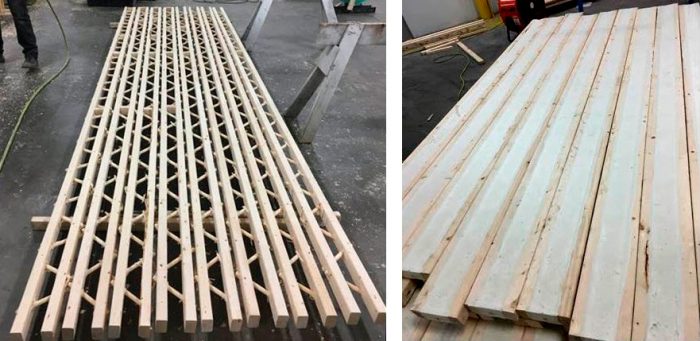


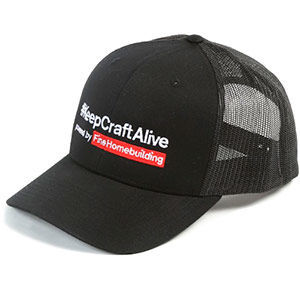



























View Comments
Regarding the T studs, I agree with all of Patrick's criticisms, and especially his concern over the effect of insulation batts. I am an increasing fan of Mineral wool (Roxol) and they are extremely well fitted, unlike fiberglass. At around R4 per inch I think they are a great bang for the buck, but they would fit terribly in a space that didn't come out to 22.5 or 14.5 inches. You would wind up with inches near each stud that were uninsulated. Sure cutting them is possible, but there is no way this is practical for the a whole house. This said it seems like the assumption is to use spray foam, however as someone trying to be a greener builder I minimize the use of foam and vinyl in projects.